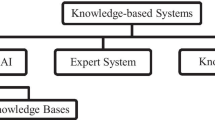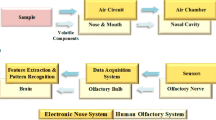Abstract
An investigation was made to evaluate the capacity of a colorimetric artificial nose to detect toxic gas at low concentration. A low-cost and simple colorimetric sensor array for identification and quantification of NH3 with different concentrations (30, 90, 150, and 210 ppb) were reported. Using porphyrin, porphyrin derivatives (mainly metalloporphyrins), and chemically responsive dyes as the sensing elements, the developed sensor array of artificial nose showed a unique pattern of colorific change upon its exposure to NH3 with different concentrations. The dynamic responses of colorimetric sensor array to NH3 and colorimetric sensor array to various NH3 concentrations at the same time point showed that there was a positive relationship between the color change values of spots and contractions of NH3. NH3 with four concentrations were measured, and the response values at six different collection times were conducted by linear discrimination analysis (LDA) and artificial neural network (ANN). The four concentrations were discriminated completely by LDA. The response value of the colorimetric artificial nose at 0.4 min was optimum for discrimination. The method of ANN was performed and less than 5% of error by using T-S fuzzy neural network.








Similar content being viewed by others
References
Alimelli, A., Pennazza, G., Santonico, M., Paolesse, R., Filippini, D., D'Amico, A., Lundström, I., & Di Natale, C. (2007). Fish freshness detection by a computer screen photoassisted based gas sensor array. Analytica Chimica Acta, 582, 320–328.
Bang, J. H., Lim, S. H., Park, E., & Suslick, K. S. (2008). Chemically responsive nanoporous pigments: colorimetric sensor arrays and the identification of aliphatic amines. Langmuir, 24, 13168–13172.
Capone, S., Siciliano, P., Bârsan, N., Weimar, U., & Vasanelli, L. (2001). Analysis of CO and CH4 gas mixtures by using a micromachined sensor array. Sensors and Actuators B: Chemical, 78, 40–48.
Cho, J. H., Kim, Y. W., Na, K. J., & Jeon, G. J. (2008). Wireless electronic nose system for real-time quantitative analysis of gas mixtures using micro-gas sensor array and neuro-fuzzy network. Sensors and Actuators B: Chemical, 134, 104–111.
Correia, D. P. A., Magalhães, J. M. C. S., & Machado, A. A. S. C. (2005). Array of potentiometric sensors for simultaneous analysis of urea and potassium. Talanta, 67, 773–782.
Escuderos, M. E., Sánchez, S., & Jiménez, A. (2010). Virgin olive oil sensory evaluation by an artificial olfactory system, based on quartz crystal microbalance (QCM) sensors. Sensors and Actuators B: Chemical, 147, 159–164.
Fa, H., Yin, W., Hou, C., Zheng, W., Wang, D., & Wang, X. (2009). Photochemical and electrochemical properties of porphyrin dimers containing an anhydride spacer. Journal of Coordination Chemistry, 62, 1151–1161.
Feng, L., Musto, C. J., Kemling, J. W., Lim, S. H., & Suslick, K. S. (2010). A colorimetric sensor array for identification of toxic gases below permissible exposure limits. Chemical Communications (Cambridge, England), 46, 2037–2039.
Feng, L., Musto, C. J., & Suslick, K. S. (2010). A simple and highly sensitive colorimetric detection method for gaseous formaldehyde. Journal of the American Chemical Society, 132, 4046–4047.
Garcia, H., Baumes, L. A., Sogo, M. B., Montes-Navajas, P., & Corma, A. (2009). First colorimetric sensor array for the identification of quaternary ammonium salts. Tetrahedron Letters, 50, 7001–7004.
Hai, Z., & Wang, J. (2006). Electronic nose and data analysis for detection of maize oil adulteration in sesame oil. Sensors and Actuators B: Chemical, 119, 449–455.
Hammond, M. H., Johnson, K. J., Rose-Pehrsson, S. L., Ziegler, J., Walker, H., Caudy, K., Gary, D., & Tillett, D. (2006). A novel chemical detector using cermet sensors and pattern recognition methods for toxic industrial chemicals. Sensors and Actuators B: Chemical, 116, 135–144.
Hou, C., Dong, J., Zhang, G., Lei, Y., Yang, M., Zhang, Y., Liu, Z., Zhang, S., & Huo, D. (2011). Colorimetric artificial tongue for protein identification. Biosensors and Bioelectronics, 26, 3981–3986.
Huo, D.-Q., Zhang, G.-P., Hou, C.-J., Dong, J.-L., Zhang, Y.-C., Liu, Z., Luo, X.-G., Fa, H.-B., & Zhang, S.-Y. (2010). A colorimetric sensor array for identification of natural amino acids. Chinese Journal of Analytical Chemistry, 38, 1115–1120.
Kermani, B. G., Schiffman, S. S., & Nagle, H. T. (2005). Performance of the Levenberg–Marquardt neural network training method in electronic nose applications. Sensors and Actuators B: Chemical, 110, 13–22.
Kim, J.-D., Byun, H.-G., Kim, D.-J., Ham, Y.-K., Jung, W.-S., & Yoon, C.-O. (2006). A simple taste analyzing system design for visual and quantitative analysis of different tastes using multi-array chemical sensors and pattern recognition techniques. Talanta, 70, 546–555.
Kim, P., Albarella, J. D., Carey, J. R., Placek, M. J., Sen, A., Wittrig, A. E., & McNamara, W. B. (2008). Towards the development of a portable device for the monitoring of gaseous toxic industrial chemicals based on a chemical sensor array. Sensors and Actuators B-Chemical, 134, 307–312.
Kramer, K. E., Rose-Pehrsson, S. L., Hammond, M. H., Tillett, D., & Streckert, H. H. (2007). Detection and classification of gaseous sulfur compounds by solid electrolyte cyclic voltammetry of cermet sensor array. Analytica Chimica Acta, 584, 78–88.
Kukla, A. L., Pavluchenko, A. S., Shirshov, Y. M., Konoshchuk, N. V., & Posudievsky, O. Y. (2009). Application of sensor arrays based on thin films of conducting polymers for chemical recognition of volatile organic solvents. Sensors and Actuators B: Chemical, 135, 541–551.
Lee, S. H., Ko, H. J., & Park, T. H. (2009). Real-time monitoring of odorant-induced cellular reactions using surface plasmon resonance. Biosensors and Bioelectronics, 25, 55–60.
Lim, S. H., Musto, C. J., Park, E., Zhong, W., & Suslick, K. S. (2008). A colorimetric sensor array for detection and identification of sugars. Organic Letters, 10, 4405–4408.
Lim, S. H., Feng, L., Kemling, J. W., Musto, C. J., & Suslick, K. S. (2009). An optoelectronic nose for the detection of toxic gases. Nature Chemistry, 1, 562–567.
Ling, S., Gao, T., Liu, J., Li, Y., Zhou, J., Li, J., Zhou, C., Tu, C., Han, F., & Ye, X. (2010). The fabrication of an olfactory receptor neuron chip based on planar multi-electrode array and its odor-response analysis. Biosensors and Bioelectronics, 26, 1124–1128.
Liu, Q., Ye, W., Hu, N., Cai, H., Yu, H., & Wang, P. (2010). Olfactory receptor cells respond to odors in a tissue and semiconductor hybrid neuron chip. Biosensors and Bioelectronics, 26, 1672–1678.
Liu, Q., Ye, W., Xiao, L., Du, L., Hu, N., & Wang, P. (2010). Extracellular potentials recording in intact olfactory epithelium by microelectrode array for a bioelectronic nose. Biosensors and Bioelectronics, 25, 2212–2217.
Liu, Q., Ye, W., Yu, H., Hu, N., Du, L., Wang, P., & Yang, M. (2010). Olfactory mucosa tissue-based biosensor: a bioelectronic nose with receptor cells in intact olfactory epithelium. Sensors and Actuators B: Chemical, 146, 527–533.
Lu, H.-H., Rao, Y. K., Wu, T.-Z., & Tzeng, Y.-M. (2009). Direct characterization and quantification of volatile organic compounds by piezoelectric module chips sensor. Sensors and Actuators B: Chemical, 137, 741–746.
Musto, C. J., Lim, S. H., & Suslick, K. S. (2009). Colorimetric detection and identification of natural and artificial sweeteners. Analytical Chemistry, 81, 6526–6533.
Rakow, N. A., Sen, A., Janzen, M. C., Ponder, J. B., & Suslick, K. S. (2005). Molecular recognition and discrimination of amines with a colorimetric array. Angewandte Chemie International Edition, 44, 4528–4532.
Scheibert, J., Leurent, S., Prevost, A., & Debrégeas, G. (2009). The role of fingerprints in the coding of tactile information probed with a biomimetic sensor. Science, 323, 1503–1506.
Sen, A., Albarella, J. D., Carey, J. R., Kim, P., & McNamara, W. B. (2008). Low-cost colorimetric sensor for the quantitative detection of gaseous hydrogen sulfide. Sensors and Actuators B-Chemical, 134, 234–237.
Shaffer, R. E., Rose-Pehrsson, S. L., & McGill, R. A. (1999). A comparison study of chemical sensor array pattern recognition algorithms. Analytica Chimica Acta, 384, 305–317.
Suslick, K. S., Rakow, N. A., & Sen, A. (2004). Colorimetric sensor arrays for molecular recognition. Tetrahedron, 60, 11133–11138.
Suslick, K. S., Lim, S. H., Kemling, J. W., & Feng, L. (2009). A colorimetric sensor array of porous pigments. Analyst, 134, 2453–2457.
Suslick, K. S., Suslick, B. A., & Feng, L. (2010). Discrimination of complex mixtures by a colorimetric sensor array: coffee aromas. Analytical Chemistry, 82, 2067–2073.
Tomchenko, A. A., Harmer, G. P., & Marquis, B. T. (2005). Detection of chemical warfare agents using nanostructured metal oxide sensors. Sensors and Actuators B: Chemical, 108, 41–55.
Vidic, J., Pla-Roca, M., Grosclaude, J., Persuy, M.-A., Monnerie, R., Caballero, D., Errachid, A., Hou, Y., Jaffrezic-Renault, N., Salesse, R., Pajot-Augy, E., & Samitier, J. (2007). Gold surface functionalization and patterning for specific immobilization of olfactory receptors carried by nanosomes. Analytical Chemistry, 79, 3280–3290.
Vidic, J., Grosclaude, J., Monnerie, R., Persuy, M.-A., Badonnel, K., Baly, C., Caillol, M., Briand, L., Salesse, R., & Pajot-Augy, E. (2008). On a chip demonstration of a functional role for odorant binding protein in the preservation of olfactory receptor activity at high odorant concentration. Lab on a Chip, 8, 678–688.
Xiao-gang, L., Ping, L., Chang-jun, H., Dan-qun, H., Jia-le, D., Huan-bao, F. and Mei, Y. (2010). A novel chemical detector using colorimetric sensor array and pattern recognition methods for the concentration analysis of NH/sub 3. Review of Scientific Instruments, 105113–105116.
Xu, Z., Shi, X., Wang, L., Luo, J., Zhong, C.-J., & Lu, S. (2009). Pattern recognition for sensor array signals using fuzzy ARTMAP. Sensors and Actuators B: Chemical, 141, 458–464.
Yoon, H., Lee, S. H., Kwon, O. S., Song, H. S., Oh, E. H., Park, T. H., & Jang, J. (2009). Polypyrrole nanotubes conjugated with human olfactory receptors: high-performance transducers for FET-type bioelectronic noses. Angewandte Chemie International Edition, 48, 2755–2758.
Zhang, C., & Suslick, K. S. (2007). Colorimetric sensor array for soft drink analysis. Journal of Agricultural and Food Chemistry, 55, 237–242.
Zhang, C., Bailey, D. P., & Suslick, K. S. (2006). Colorimetric sensor arrays for the analysis of beers: a feasibility study. Journal of Agricultural and Food Chemistry, 54, 4925–4931.
Zhang, H., Wang, J., Tian, X., Yu, H., & Yu, Y. (2007). Optimization of sensor array and detection of stored duration of wheat by electronic nose. Journal of Food Engineering, 82, 403–408.
Acknowledgments
The authors are grateful for the financial support from the Fundament Research Funds for the Central Universities (#CDJXS10 23 1117, #CDJXS10 23 00), National Natural Science Foundation (#81171414), National High Technology Research and Development Program of China 863 Program (#2006AA04Z349), Chongqing Natural Science Foundation (#2008AB2024, #2008AC7037), and the Ministry of Education College Doctoral Fund (#20090191110030) and the sharing fund of Chongqing University’s large-scale equipment.
Author information
Authors and Affiliations
Corresponding authors
Additional information
Zhang Ya and Xiao-gang Luo contributed equally to this article.
Rights and permissions
About this article
Cite this article
Zhang, Y., Luo, Xg., He, K. et al. Colorimetric Artificial Nose and Pattern Recognition Methods for the Concentration Analysis of NH3 . Water Air Soil Pollut 223, 2969–2977 (2012). https://doi.org/10.1007/s11270-012-1080-1
Received:
Accepted:
Published:
Issue Date:
DOI: https://doi.org/10.1007/s11270-012-1080-1




